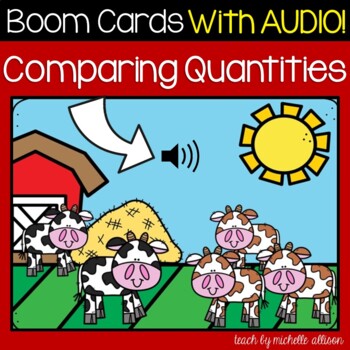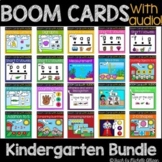Math Boom Cards - Counting Games for Comparing Numbers to 10 & More and Less
- PDF
- Internet Activities
Also included in
- Numbers to 10 | Number Sense | Comparing Numbers | BOOM Cards™This growing bundle will keep your students will enthusiastic about developing their number sense and counting skills until the cows come home! This barnyard themed BUNDLE of BOOM Cards is a great addition to your math centers and distanPrice $16.40Original Price $20.50Save $4.10
- Kindergarten Math Games | Phonics Games | BOOM Cards Are you looking for phonics games? How about math games? This bundle of BOOM Card with audio will simplify your planning for kindergarten phonics and math! The decks of BOOM Cards in this bundle include interactive games that build phonologicalPrice $41.83Original Price $59.75Save $17.92
Description
Explore our Math Boom Cards, featuring engaging counting games that teach kids to compare numbers up to 10, understand concepts of more and less and greater and less than in a fun, interactive way!
Comparing numbers to determine more and less is important to develop early math skills. This deck of BOOM Cards includes 30 cards for students to use counting strategies to compare numbers to 10. This barnyard themed deck is perfect for students that are working to identify whether the number of objects in one group is greater than, less than, or equal to the number of objects in another group. You can try this comparing numbers deck for free here!
Use this deck to model a lesson during whole group instruction, reinforce skills in small groups, as independent word work centers, as a formative assessment, or as part of your data collection for RTI intervention!
WHAT'S INCLUDED?
This resource includes:
✅ a PDF document with a link to download the Boom Cards hosted on BOOM Learning: Comparing Numbers More and Less | Counting Strategies | BOOM Cards with AUDIO!
✅ Audio on each card
Terms
Copyright © Michelle Staley. All rights reserved by the author. This product is to be used by the original downloader only. Copying for more than one teacher, classroom, department, school, or school system is prohibited. This product may not be distributed or displayed digitally for public view. Failure to comply is a copyright infringement and a violation of the Digital Millennium Copyright Act (DMCA). Clipart and elements found in this PDF are copyrighted and cannot be extracted and used outside of this file without permission or license. Intended for classroom and personal use ONLY. See product file for clip-art and font credits.
Important Information from BOOM Learning
Using Boom Cards: To use Boom Cards, you must be connected to the Internet. Boom Cards play on modern browsers (Chrome, Safari, Firefox, and Edge). Apps are available for Android, iPads, iPhones, and Kindle Fires. For security and privacy, adults must have a Boom Learning account to use and assign Boom Cards. You will be able to assign the Boom Cards you are buying with "Fast Pins," (play provides instant feedback for self-grading Boom Cards). Fast Play is always a free way for students to engage with Boom Cards decks. For additional assignment options, you'll need a premium account. If you are new to Boom Learning, you will be offered a free trial of our premium account. Read here for details: http://bit.ly/BoomTrial.
Common Core State Standard Correlations:
Know number names and the count sequence.
K.CC.A.1
Count to 100 by ones and by tens.
K.CC.A.2
Count forward beginning from a given number within the known sequence (instead of having to begin at 1).
Count to tell the number of objects.
K.CC.B.4
Understand the relationship between numbers and quantities; connect counting to cardinality.
K.CC.B.4.A
When counting objects, say the number names in the standard order, pairing each object with one and only one number name and each number name with one and only one object.
K.CC.B.4.B
Understand that the last number name said tells the number of objects counted. The number of objects is the same regardless of their arrangement or the order in which they were counted.
K.CC.B.4.C
Understand that each successive number name refers to a quantity that is one larger.
K.CC.B.5
Count to answer "how many?" questions about as many as 20 things arranged in a line, a rectangular array, or a circle, or as many as 10 things in a scattered configuration; given a number from 1-20, count out that many objects.
Compare numbers.
K.CC.C.6
Identify whether the number of objects in one group is greater than, less than, or equal to the number of objects in another group, e.g., by using matching and counting strategies.







